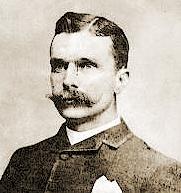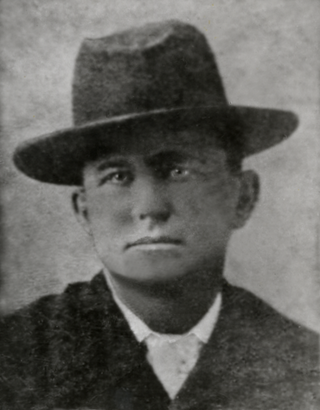Related Research Articles

Magalia is an unincorporated community and census-designated place (CDP) in Butte County, California, United States. The population was 11,310 at the 2010 census.

Lemoore is a city in Kings County, California, United States. Lemoore is located 7.5 miles (12 km) west-southwest of Hanford, at an elevation of 230 feet (70 m). It is part of the Hanford-Corcoran Metropolitan Statistical Area. The population was 24,531 at the 2010 Census. The California Department of Finance estimated that Lemoore's population was 26,725 on July 1, 2019.

Sam Bass was a 19th-century American train robber, outlaw, and outlaw gang leader. Notably, he was a member of a gang of six that robbed a Union Pacific train in Nebraska of $60,000 in newly minted gold from San Francisco, California. To date, this was the biggest train robbery ever committed in the USA. He died as a result of wounds sustained in a gun battle with law enforcement officers.

Boot Hill, or Boothill, is the given name of many cemeteries, chiefly in the Western United States. During the 19th and early 20th century it was a common name for the burial grounds of gunfighters, or those who "died with their boots on".

Bannack is a ghost town in Beaverhead County, Montana, United States, located on Grasshopper Creek, approximately 11 miles (18 km) upstream from where Grasshopper Creek joins with the Beaverhead River south of Dillon. Founded in 1862, the town is a National Historic Landmark managed by the state of Montana as Bannack State Park.

Dog Town is a gold rush era ghost town in Mono County, California. It is located at 38°10′13″N119°11′51″W, on Dog Creek, near the junction of Clearwater and Virginia Creeks, about 6 miles (10 km) south-southeast of Bridgeport, at an elevation of 7057 feet.

Contention City or Contention is a ghost mining town in Cochise County in the southeastern part of the U.S. state of Arizona. It was occupied from the early-1880s through the late-1880s in what was then known as the Arizona Territory. Only a few foundations now remain of this boomtown which was settled and abandoned with the rise and fall of silver mining in and around the area of Tombstone.

Rawhide is a 1951 Western film produced by Twentieth Century-Fox. It was directed by Henry Hathaway and produced by Samuel G. Engel from a screenplay by Dudley Nichols. The music score was by Sol Kaplan and the song "A Rollin' Stone" by Lionel Newman. The cinematography was by Milton R. Krasner.

Mason Frakes Dalton, called Bill Dalton, was an American outlaw in the American Old West. He was the co-leader of the Wild Bunch gang and he was the brother of the founders of the Dalton Gang, Gratton, Bob and Emmett.
Red Dog was a California gold rush mining town located in the Gold Country in south-central Nevada County, California, United States, 6 mi (9.7 km) northeast of Chicago Park. Red Dog Hill, a mine and campsite, was founded by three men all under the age of 22, and was named by their youngest, a 15-year-old prospector. As mining operations grew, the campsite became a settlement, and then a town with a population of 2,000 residents, before it was eventually abandoned. Still considered important today, Red Dog Townsite is listed on the National Register of Historic Places.
The White River is a small river in the southern San Joaquin Valley of the U.S. state of California. The river is 50.7 miles (81.6 km) long and flows entirely within Tulare County. It rises at roughly 6,800 feet (2,100 m) above sea level in the foothills of the Sierra Nevada on the northwest slope of Bull Run Peak. It flows west, receiving several seasonal tributaries including Arrastre Creek, Coarse Gold Creek and Coho Creek, passing the small settlement of White River. As it nears the border of Tulare County and Kern County its surface flow disappears. The dry riverbed continues northwest into the agricultural San Joaquin Valley and is diverted into canals for flood control and irrigation purposes. The river terminates about 5 miles (8.0 km) north of Delano, short of the historic Tulare Lake.
Jack Gordon (1822–1864), original name, Peter Worthington, renegade, outlaw, in Texas, New Mexico and Arizona. Later moving to California he became a member of the Mason Henry Gang.
The Stockton–Los Angeles Road, also known as the Millerton Road, Stockton–Mariposa Road, Stockton–Fort Miller Road or the Stockton–Visalia Road, was established about 1853 following the discovery of gold on the Kern River in Old Tulare County. This route between Stockton and Los Angeles followed by the Stockton–Los Angeles Road is described in "Itinerary XXI. From Fort Yuma to Benicia, California", in The Prairie Traveler: A Hand-book for Overland Expeditions by Randolph Barnes Marcy. The Itinerary was derived from the report of Lieutenant R. S. Williamson on his topographical survey party in 1853, that was in search of a railroad route through the interior of California.

The Battleground Gunfight, also known as the Battleground Shootout, was a gunfight between a posse of American lawmen and the Smith Gang. It was fought on October 8, 1901, within Arizona Territory's Fort Apache Indian Reservation, at a clearing in the forest known today as the "Battleground". Nine Arizona Rangers and deputies caught up with the cattle rustler Bill Smith and his gang. During a long exchange of gunfire that followed, Ranger Carlos Tafolla and Deputy Bill Maxwell were killed and one or two of the outlaws may have been wounded. In the end, the Smith Gang escaped the posse and fled into Mexico.
The Mason Henry Gang were bandits operating in Central and Southern California in 1864–1865. As the Civil War was in progress, they were able to pose as Confederate Partisan Rangers, and their original mission was to rid the area of (anti-slavery) Republicans. But when it became clear that the Confederate cause was lost, they turned to outlawry, plundering and killing without mercy.
Stickneys Ferry was a settlement established in what became Tulare County after the Williamson Expedition of the Pacific Railroad Surveys of 1853 and before 1857, on what became the Stockton - Los Angeles Road and the crossing of the White River. It was probably established sometime between 1854 and 1856 because of the Kern River Gold Rush.
Gun Brothers is a 1956 American Western film starring Buster Crabbe and Ann Robinson. It was Crabbe's first feature film in six years.

The Arizona Ranger is a 1948 American Western film directed by John Rawlins and starring Tim Holt and his father Jack.
The Marshal of Mesa City is a 1939 American Western film directed by David Howard from a screenplay by Jack Lait Jr..

Millwood was a lumber boomtown located in present-day Sequoia National Forest near Converse Basin Grove in California. It was established in 1891 by the Kings River Lumber Company and was connected to the Sequoia Railroad, which brought logs to the town to be turned into rough lumber. The lumber was then transported by log flume to Sanger, a journey of 54 miles. At its peak, Millwood had a population of over 2,000 people and featured two hotels, a summer school, and a post office. However, today there are no remaining structures or buildings at the Millwood site.
References
- ↑ "Tailholt". Office of Historic Preservation, California State Parks. Retrieved 2012-10-18.
- ↑ Historic Spots in California, Third Edition, pg. 563 Tailholt, Tulare County
- ↑ Tailholt Boot Hill Cemetery
- ↑ [Jack Gordon buried in the Tailholt Boot Hill Cemetery, died in a gunfight. A known member of the Mason Henry Gang. Frank F. Latta, Tailholt Tales, Brewer's Historical Press (February 1, 1976)]
- ↑ Jack Peter Worthington Gordon
